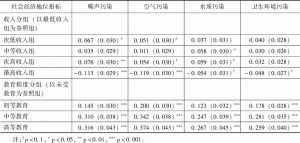论文
环境污染感知与精神健康不平等
摘要
环境污染对精神健康的影响以及对于整体精神健康不平等模式的作用目前仍缺乏社会学视角的研究证据。本文以压力过程模型为基本理论框架,运用2013年中国社会状况综合调查数据(CSS 2013),检验社会经济地位指标通过对居住地四种环境污染的感知对我国居民精神健康发生作用的双机制模型。结果显示,高社会经济地位群体对四种污染的感知程度均更高,而高污染感知会显著降低精神健康水平,因此,污染感知的压力暴露(中介)路径并非精神健康不平等的作用机制;但是,随着收入升高,卫生环境污染感知与精神健康的负相关关系减弱,因此,针对此类环境压力而言,压力暴露机制与脆弱性(调节)机制同时存在,后者对低收入者的精神健康不利,是导致精神健康不平等的原因之一。本研究厘清了污染感知压力与传统社会性压力在运作机制上的异同,同时也对于改善低收入者的居住卫生环境具有政策启示性。
作者
检索正文关键字
论文目录
- 一、引言
-
二、文献综述及假设
- (一)背景:精神健康的社会分层
- (二)压力过程模型之压力暴露机制
- 1.社会经济地位与环境污染感知的相关性
- 2.环境污染感知与精神健康的相关性
- (三)压力过程模型之脆弱性机制
- (四)研究设计
-
三、研究方法
- (一)数据
- (二)测量
- 1.因变量:精神健康
- 2.自变量
- (三)分析模型与策略
-
四、研究结果
- (一)描述性分析
- (二)社会经济地位指标与精神健康的相关性检验
- (三)压力暴露路径的中介效应检验
- (四)双机制共同作用模型
- 五、讨论与结论
查看更多>>>













